SEIKAKU TECHNICAL GROUP LYNX-MIXER Compact Integrated Live Sound Mixer with Digital Effects User Manual
SEIKAKU TECHNICAL GROUP LIMITED Compact Integrated Live Sound Mixer with Digital Effects Users Manual
Users Manual
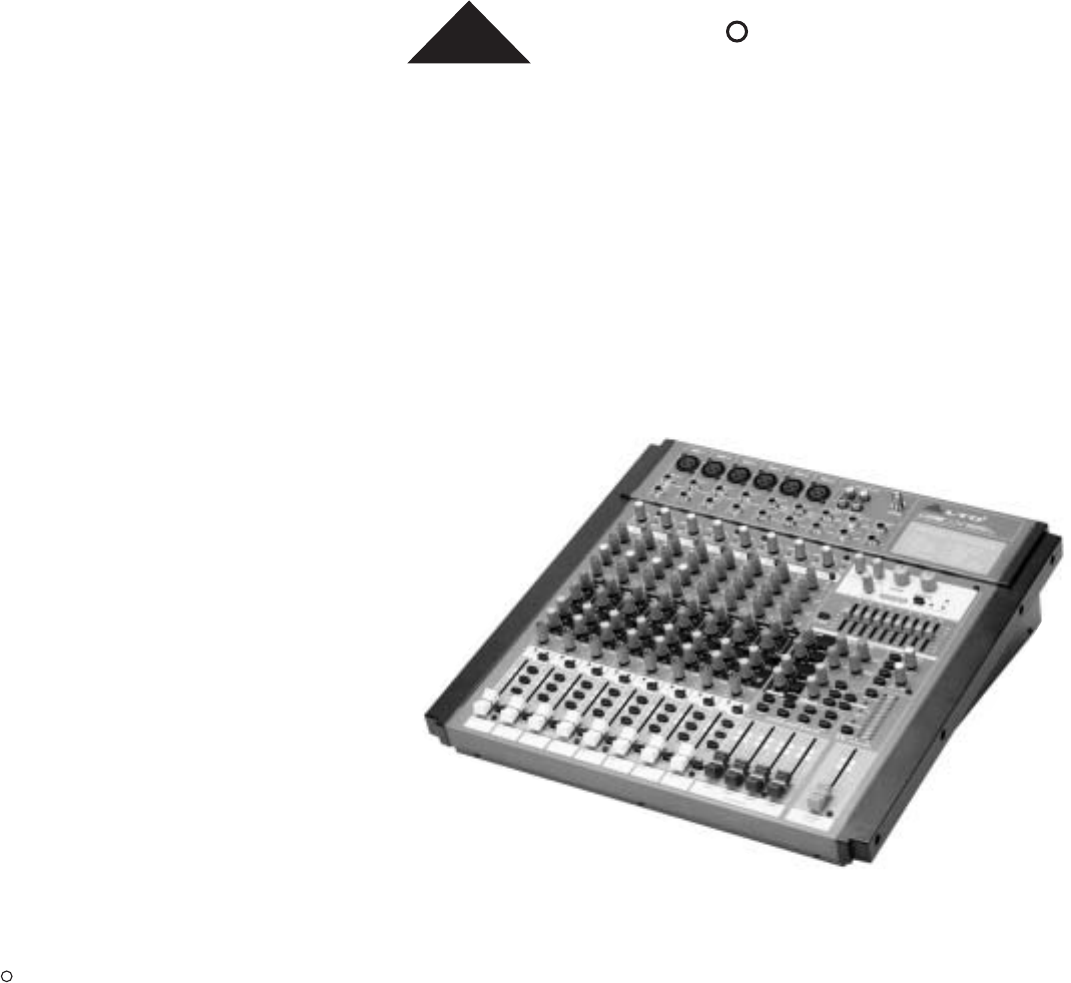
LYNX-MIX USB SERIES
12/16/20-CH COMPACT INTEGRATED LIVE SOUND
MIXER WITH DIGITAL EFFECTS
USER'S MANUAL
www.altoproaudio.com
Version 2.0 OCT. 2007
LTO
R
English
c
All rights reserved to ALTO. All features and content might be changed
without prior notice. Any photocopy, translation, or reproduction of part of this
manual without written permission is forbidden. Copyright 2007 Seikaku Group
SEIKAKU TECHNICAL GROUP LIMITED
NO. 1, Lane 17, Sec. 2, Han Shi West Road, Taichung 40151, Taiwan
http://www.altoproaudio.com Tel: 886-4-22313737
email: alto@altoproaudio.com Fax: 886-4-22346757
10-1
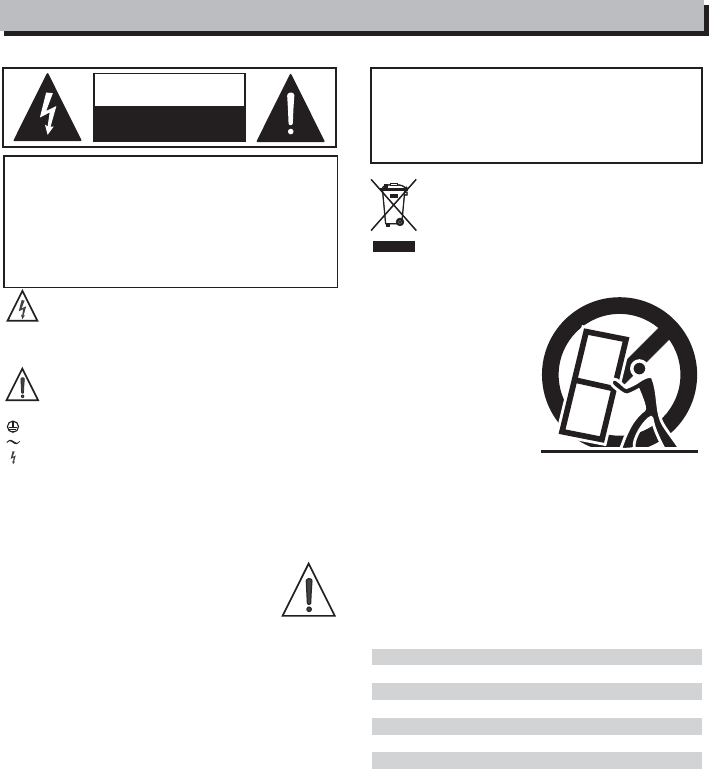
IMPORTANT SAFETY INSTRUCTION
CAUTION
RISK OF ELECTRIC SHOCK
DO NOT OPEN
TO REDUCE THE RISK OF ELECTRIC SHOCK
PLEASE DO NOT REMOVE THE COVER OR
THE BACK PANEL OF THIS EQUIPMENT.
THERE ARE NO PARTS NEEDED BY USER
INSIDE THE EQUIPMENT. FOR SERVICE,
PLEASE CONTACT QUALIFIED SERVICE
CENTERS.
WARNING
To reduce the risk of electric shock
and fire, do not expose this equipment
to moisture or rain.
1.
2.
3.
4.
5.
6.
7.
8.
9.
10.
Dispose of this product should
notbeplacedinmunicipalwaste
and should be separate collection.
11.
12.
MovethisEquipmentonlywithacart,
stand, tripod, or bracket,
specified by the
manufacturer, or
sold with the
Equipment. When
a cart is used, use
caution when
moving the cart /
equipment
combination to
avoid possible
injury from tip-over.
Permanent hearing loss may be caused by
exposure to \ extremely high noise levels.
The US. Government's Occupational Safety
and Health Administration (OSHA) has
specified the permissible exposure to noise
level.
These are shown in the following chart:
HOURS X DAY SPL EXAMPLE
According to OSHA, an exposure to high SPL in
excess of these limits may result in the loss of
heat. To avoid the potential damage of heat, it is
recommended that Personnel exposed to
equipment capable of generating high SPL use
hearing protection while such equipment is
under operation.
8
6
4
3
2
1,5
1
0,5
0,25 or less
90
92
95
97
100
102
105
110
115
Small gig
train
Subway train
High level desktop monitors
Classic music concert
Rock concert
This symbol, wherever used, alerts you to the
presence of un-insulated and dangerous voltages
within the product enclosure. These are voltages that
may be sufficient to constitute the risk of electric
shock or death.
This symbol, wherever used, alerts you to
important operating and maintenance instructions.
Please read.
Protective Ground Terminal
AC mains (Alternating Current)
Hazardous Live Terminal
ON: Denotes the product is turned on.
OFF: Denotes the product is turned off.
The apparatus shall be connected to a mains
socket outlet with a protective earthing
connection.
The mains plug or an appliance coupler is used
as the disconnect device, the disconnect device
shall remain readily operable.
CAUTION
Describes precautions that should be observed to
prevent damage to the product.
Read this Manual carefully before operation.
Keep this Manual in a safe place.
Be aware of all warnings reported
with this symbol.
Keep this Equipment away from water and
moisture.
Clean it only with dry cloth. Do not use
solvent or other chemicals.
Do not damp or cover any cooling opening.
Install the equipment only in accordance with
the Manufacturer's instructions.
Power Cords are designed for your safety. Do
not remove Ground connections! If the plug
does not fit your AC outlet, seek advice from
a qualified electrician. Protect the power
cord and plug from any physical stress to
avoid risk of electric shock. Do not place
heavy objects on the power cord. This could
cause electric shock or fire.
Unplug this equipment when unused for long
periods of time or during a storm.
Refer all service to qualified service personnel
only. Do not perform any servicing other than
those instructions contained within the
User's Manual.
To prevent fire and damage to the product,
use only the recommended fuse type as
indicated in this manual. Do not short-circuit
the fuse holder. Before replacing the fuse,
make sure that the product is OFF and
disconnected from the AC outlet.
FCC COMPLIANCE NOTICE
This device complies with Part 15 of the FCC Rules.
Operation is subject to the following two conditions:
(1) this device may not cause harmful interference, and
(2) this device must accept any interference received,
including interference that may cause undesired operation.
WARNING: changes or modifications not expressly
approved by the party responsible for compliance could
void the user's authority to operate the equipment.
NOTE:This equipment has been tested and found to comply with the limits for a Class
B digital device, pursuant to Part 15 of the FCC Rules. These limits are designed to
provide reasonable protection against harmful interference in a residential installation.
This equipment generates, uses and can radiate radio frequency energy and, if not
installed and used in accordance with the instructions, may cause harmful interference
to radio communications. Howerver, there is no guarantee that interference will not
occur in a particular installation. If this equipment does cause harmful interference to
radio or television reception.
which can be determined by turning the equipment off and on, the user is encouraged
to try to correct the interference by one or more of the following measures:
--Reorient or relocate the receiving antenna.
--Increase the separation between the equipment and receiver.
--Connect the equipment into an outlet on a circuit different form that to which the
receiver is connected.
--consult the dealer or an experienced radio/TV technician for help.
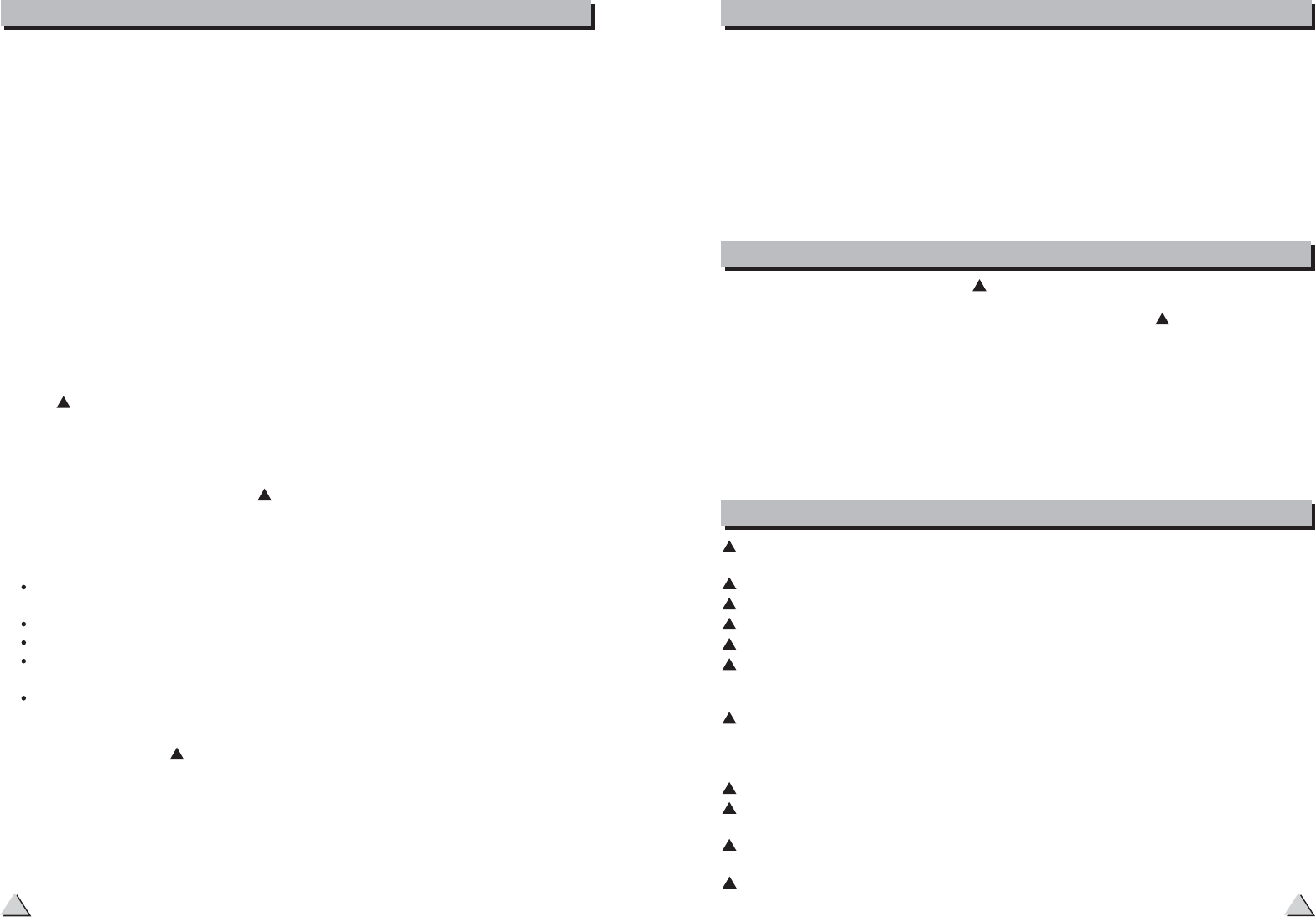
24
9. WARRANTY
1. WARRANTY REGISTRATION CARD
To obtain Warranty Service, the buyer should first fill out and return the enclosed
Warranty Registration Card within 10 days of the Purchase Date.
All the information presented in this Warranty Registration Card gives the
manufacturer a better understanding of the sales status, so as to provide a
more effective and efficient after-sales warranty service. Please fill out all the
information carefully and genuinely, miswriting or absence of this card will void
your warranty service.
2. RETURN NOTICE
2.1 In case of return for any warranty service, please make sure that the product
is well packed in its original shipping carton, and it can protect your unit from
any other extra damage.
2.2 Please provide a copy of your sales receipt or other proof of purchase with
the returned machine, and give detail information about your return address
and contact telephone number.
2.3 A brief description of the defect will be appreciated.
2.4 Please prepay all the costs involved in the return shipping, handling and
insurance.
3. TERMS AND CONDITIONS
3.1 LTO warrants that this product will be free from any defects in materials
and/or workmanship for a period of 1 year from the purchase date if you
have completed the Warranty Registration Card in time.
3.2 The warranty service is only available to the original consumer, who purchased
this product directly from the retail dealer, and it can not be transferred.
3.3 During the warranty service, LTO may repair or replace this product at its
own option at no charge to you for parts or for labor in accordance with the
right side of this limited warranty.
3.4 This warranty does not apply to the damages to this product that occurred
as the following conditions:
Instead of operating in accordance with the user's manual thoroughly, any abuse
or misuse of this product.
Normal tear and wear.
The product has been altered or modified in any way.
Damage which may have been caused either directly or indirectly by another
product / force / etc.
Abnormal service or repairing by anyone other than the qualified personnel or
technician.
And in such cases, all the expenses will be charged to the buyer.
3.5 In no event shall LTO be liable for any incidental or consequential damages.
Some states do not allow the exclusion or limitation of incidental or
consequential damages, so the above exclusion or limitation may not apply to
you.
3.6 This warranty gives you the specific rights, and these rights are compatible
with the state laws, you may also have other statutory rights that may vary
from state to state.
1. INTRODUCTION................................................................................1
2. FEATURES.......................................................................................1
4. CONTROL ELEMENTS......................................................................5
5. INSTALLATION & CONNECTION......................................................15
1. INTRODUCTION
2. FEATURES
1
7. BLOCK DIAGRAM..........................................................................20
8. TECHNICAL SPECIFICATIONS..........................................................22
9. WARRANTY..................................................................................24
3. QUICK START..................................................................................3
6. PRESET LIST.................................................................................19
IN THIS MANUAL
Thank you for your purchasing of the LTO LYNX-MIX124 USB 12-channel (16-channel
for LYNX-MIX164 USB, and 20-channel for LYNX-MIX204 USB) compact integrated mixer
with 24-bit digital multi-effect built-in. It is just one of the many LTO products that a
talented, multinational Team of Audio Engineers and Musicians have developed with their
great passion for music. Your LYNX-MIX USB Series is a remarkable compact mixer that
doesn't find many equals in the market today. With 6 microphone (10 microphone for
LYNX-MIX 164USB, 14 microphone for LYNX-MIX204 USB) and 4 stereo Line-level inputs
for serious live performances, your LYNX-MIX USB Series also includes a 24-bit digital
multi-effect with 16 Factory Presets and 16 variations for every preset, for a total of
256 different digital effects. There is a three bands EQ on mono input channels, four
bands EQ on stereo input channels. Use it for large Gigs, and for fixed PA installation.
Enjoy your LYNX-MIX USB Series and make sure to read this Manual carefully before
operation!
6 MIC (10 MIC for LYNX-MIX164 USB, 14 MIC for LYNX-MIX204 USB) inputs
with gold plated XLR and balanced TRS jack
4 Stereo input channels with balanced TRS jacks
Ultra-low noise discrete MIC preamps with +48 V Phantom Power
Each mic input channel with Mute, SOLO function, Peak LED and Low Cut filter
SUB1-2, SUB3-4 & MAIN L-R signal assignment switches
4 AUX Sends per channel: 2 PRE/POST faders switchable for monitoring
application effects & sound processor input; 2 POST faders as external send
or for internal digital DFX
Channel Inserts and Direct Outputs on each mono channel plus Main Insert
for flexible connection of outboard equipment
3-band EQ with sweepable MID on mono inputs; 4-band EQ on stereo inputs
24-bit internal DSP with 256 effects, 16 presets by 16 variations with DSP
Mute switch and Peak LED
2-TRACK IN assignable to Main Mix, Control Room/Headphone outputs
With USB port, when it is in output mode, it can connect with the SUB1-2 or
MAIN MIX output; in the input mode, it can connect with the CH11/12 (for
LYNX-MIX124 USB, CH15/16 for LYNX-MIX164 USB, CH19/20 for LYNX-MIX204
USB) or MAIN MIX output
10-3
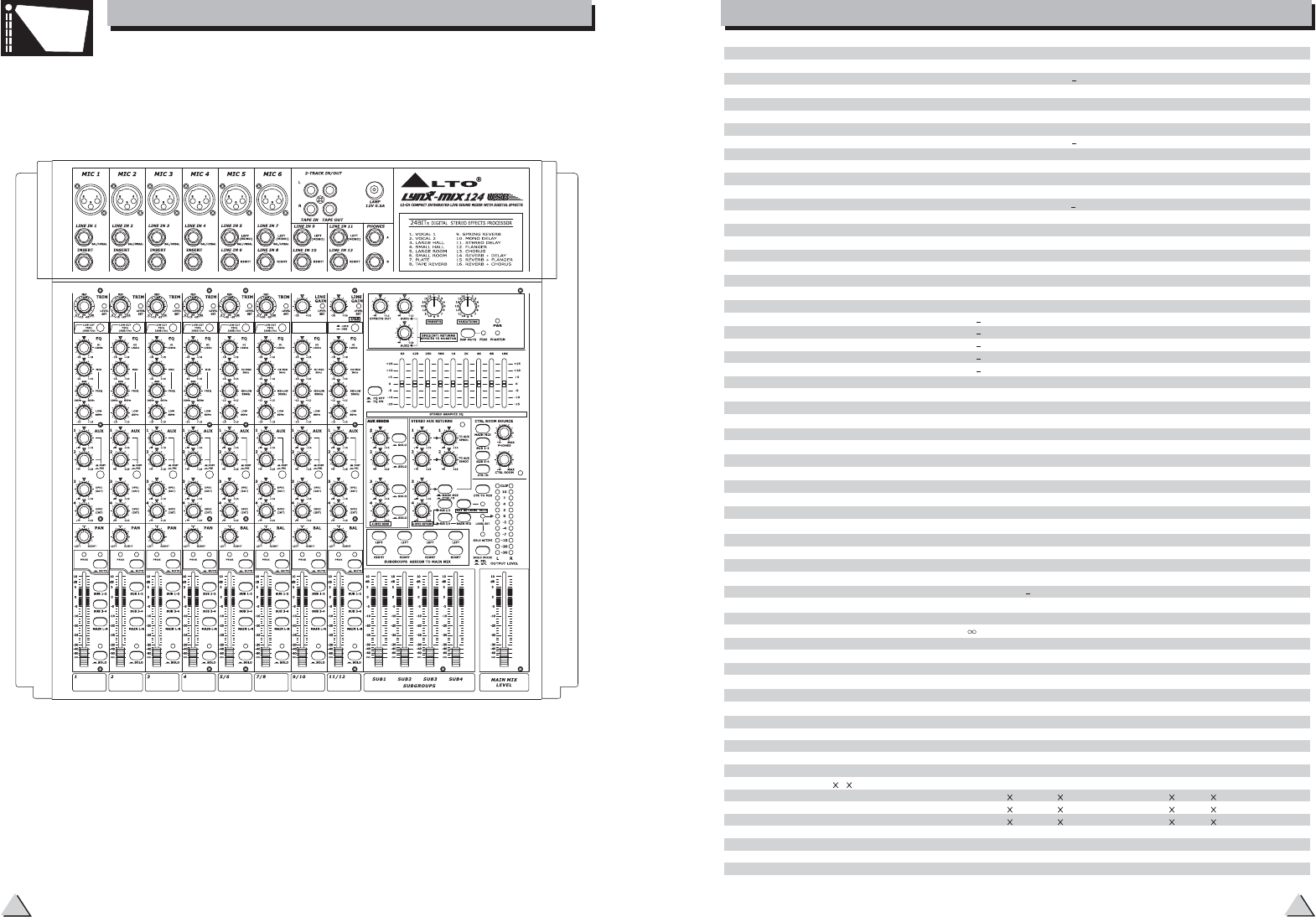
Mono input channels
Line input Balanced/Unbalanced
Distortion (THD & N) 0.005% at +4 dBu, 1 kHz
Fader 0 dB, all input channels assigned and set to
+22 dBu balanced XLR
DSP Section
Presets 256
16-position VARIATION selector
Max output
Power Supply
Europe 210-240 V~, 50 Hz
AUX Returns gain range - to +15 dB
Main Mix Section
Power Consumption 60 Watts
Microphone input electronically balanced, discrete input configuration
Frequency response 10 Hz to 55 kHz, +/ 3 dB
Distortion (THD & N) 0.005% at +4 dBu, 1 kHz
Gain range 0 dB to 50 dB (MIC)
115 dB
SNR (Signal to Noise Ratio)
electronically balanced
Line input
10 Hz to 55 kHz, +/ 3 dB
Frequency response
Distortion (THD & N) 0.005% at +4 dBu, 1 kHz
Sensitivity range +15 dBu to -35 dBu
Stereo input channels
Frequency response 10 Hz to 55 kHz, +/3dB
Impedances
All other output 120 Ohm
All other inputs 10 kOhm or greater
Microphone input 1.4 kOhm
Channel Insert return 2.5 kOhm
Tape out 1 kOhm
Equalization
Low-shelving +/ 15dB@80Hz
Hi-Mid (Stereo) +/ 15 dB @ 3 kHz
Mid bell (Mono) +/ 15 dB -frequency range 100 Hz~8 kHz
Hi-shelving +/ 15 dB @12 kHz
Mid-Low (Stereo) +/ 15 dB @ 500 Hz
Low Cut filter 75 Hz, 18 dB/Oct.
A/D and D/A converters 24-bit
DSP resolution 24-bit
Type of effects Hall, Room, Vocal & Plate REVERBS
Mono & Stereo DELAY (max DELAY TIME 650ms)
REVERB+DELAY, REVERB+CHORUS,
Chorus, Flanger & Reverb MODULATIONS
REVERB+FLANGER combinations
16-position PRESET Selector
Controls
DSP MUTE SWITCH with PEAK LED indicator
Noise (Bus noise) Fader 0 dB, channels muted: -100 dBr (ref.: +4 dBu)
UNITY gain: 90 dBr (ref.:+4 dBu)
+22 dBu unbalanced, 1/4" jacks
AUX Sends max out +22 dBu
Main voltage USA/Canada 100-120 V~,60 Hz
U.K./Australia 240 V~, 50 Hz
Fuse
Standard IEC receptacle
Main Connection
Net Weight
LYNX- 124USBMIX T500 mAL
LYNX- USBMIX164 T630 mAL
LYNX- USBMIX204 T750 mAL
Physical
518 mm 400 mm 38/115 mm (20.39" 15.75" 1.49"/4.53")
Dimension (W D H)
LYNX-MIX124USB 415 mm 400 mm 38/115 mm (16.34" 15.75" 1.49"/4.53")
LYNX-MIX164USB
LYNX-MIX204USB 626 mm 400 mm 38/115 mm (24.64" 15.75" 1.49"/4.53")
LYNX- 124USBMIX
LYNX- USBMIX204
LYNX- USBMIX164
LYNX-MIX124
SPOTLIGHT
23
8. TECHNICAL SPECIFICATION
2
5.65 Kg (12.5 lb)
8.15Kg (18 lb)
6.87 Kg (15.1 lb)
10-4
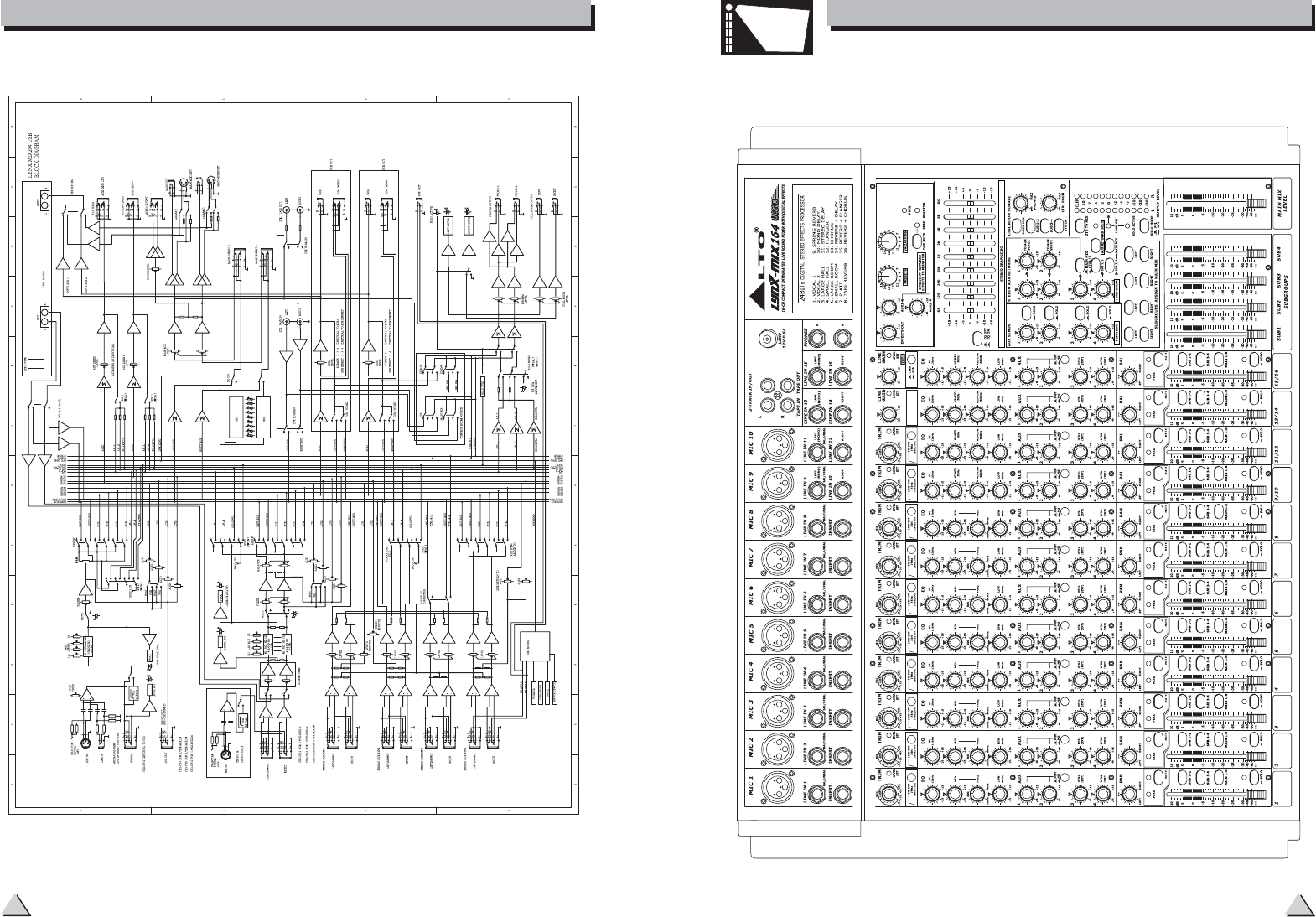
3
SPOTLIGHT
22
7. BLOCK DIAGRAM
LYNX-MIX164
10-5
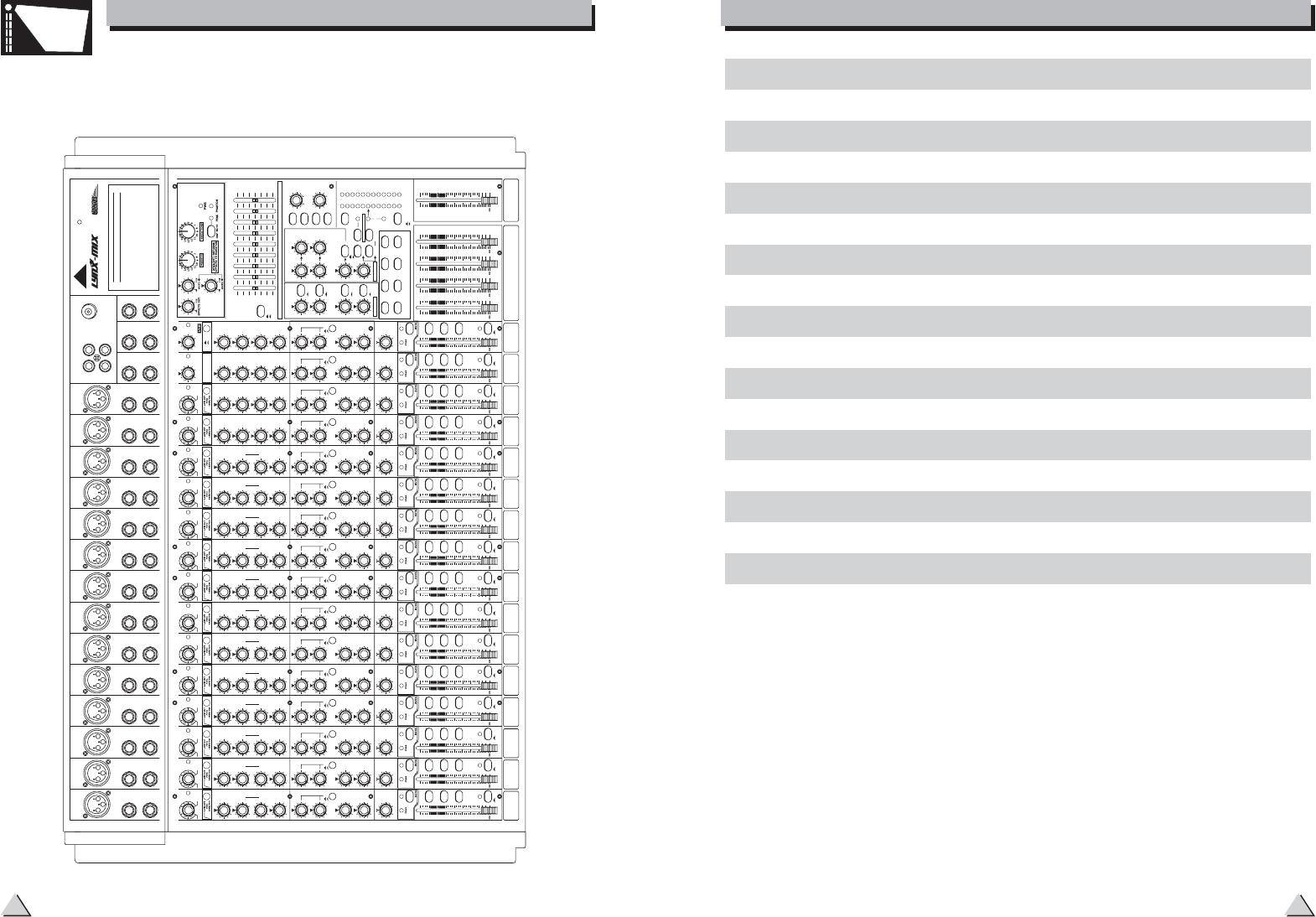
LYNX-MIX204
SPOTLIGHT
21
6. PRESET LIST
Controllable Parameter
VOCAL1 Simulate a room with small delay time Decay time
Pre-delay
Simulate a small space with slight decay timeVOCAL2
Simulate a large acoustic space of the soundLARGE HALL
Simulate a small acoustic space of the soundSMALL HALL
Simulate a studio room with many early reflectionsLARGE ROOM
Simulate a bright studio roomSMALL ROOM
Simulate the transducers sound like classic bright
vocal plate
PLATE
TAPE REVERB Simulate a record head and multiple playback heads
at intervals along the tape
SPRING REVERB Simulate the analog transducers' springs lightly
stretched sound
MONO DELAY
STEREO DELAY
FLANGER
CHORUS
REV.+DELAY
REV.+FLANGER
Reproduce the sound input on the output after a
lapse of time
Recreate the input sound on the stereo output with
different time.
Recreate the illusion of more than one instrument
from a single instrument sound
Delay with room effect
Stereo flanger and large room reverb
Rate
1
2
3
4
5
6
7
8
9
10
11
12
13
14
15
16
NO. Preset Description
Flanger Rate
Rev.decay time
Chorus rate
Rev.decay time
Simulate to play with another person carrying
out same the notes on the same instrument
REV.+CHORUS
Stereo chorus and large room reverb
Parameter Variable range
0.8~1.1s
0~79ms
Decay time
Pre-delay
0.8~2.5s
0~79ms
Decay time
Pre-delay
3.6~5.4s
23~55ms
Decay time
Pre-delay
1.0~2.9s
20~45ms
Decay time
Pre-delay
2.9~4.5s
23~55ms
Decay time
Pre-delay
0.7~2.1s
20~45ms
Decay time
Pre-delay
0.6~6.1s
10ms
Decay time
Pre-delay
1.3~5.4s
0~84ms
Decay time
Pre-delay
1.3~5.4s
0~35ms
60~650ms
0.16~2.79Hz
Period
Period
Feedback
210~400ms
37~73%
Rate 0.5~5Hz
Decay period
Rev.decay time
0.16~2.52Hz
1.5~2.9s
211~375ms
1.0~2.9s
0.5~4.74Hz
1.5~2.9s
4
10
dB
-5
-10
-20
-25
-30
-40
-60
0
5
10
dB
-5
-10
-20
-25
-30
-40
-60
0
5
10
dB
-5
-10
-20
-25
-30
-40
-60
0
5
10
dB
-5
-10
-20
-25
-30
-40
-60
0
5
10
dB
-5
-10
-20
-25
-30
-40
-60
0
5
SUB 1-2SUB 1-2SUB 1-2
SUB 3-4SUB 3-4SUB 3-4
MAIN L-RMAIN L-RMAIN L-R
SOLO
SOLOSOLO
10
dB
-5
-10
-20
-25
-30
-40
-60
0
5
10
dB
-5
-10
-20
-25
-30
-40
-60
0
5
10
dB
-5
-10
-20
-25
-30
-40
-60
0
5
10
dB
-5
-10
-20
-25
-30
-40
-60
0
5
10
dB
-5
-10
-20
-25
-30
-40
-60
0
5
10
dB
-5
-10
-20
-25
-30
-40
-60
0
5
10
dB
-5
-10
-20
-25
-30
-40
-60
0
5
10
dB
-5
-10
-20
-25
-30
-40
-60
0
5
SUB 1-2SUB 1-2SUB 1-2SUB 1-2SUB 1-2
SUB 3-4SUB 3-4SUB 3-4SUB 3-4SUB 3-4
MAIN L-RMAIN L-RMAIN L-RMAIN L-RMAIN L-R
SOLO
SOLOSOLOSOLOSOLO
10
dB
-5
-10
-20
-25
-30
-40
-60
0
5
10
dB
-5
-10
-20
-25
-30
-40
-60
0
5
10
dB
-5
-10
-20
-25
-30
-40
-60
0
5
10
dB
-5
-10
-20
-25
-30
-40
-60
0
5
10
dB
-5
-10
-20
-25
-30
-40
-60
0
5
SUB 1-2SUB 1-2SUB 1-2SUB 1-2SUB 1-2
SUB 3-4SUB 3-4SUB 3-4SUB 3-4SUB 3-4
MAIN L-RMAIN L-RMAIN L-RMAIN L-RMAIN L-R
SOLO
SOLOSOLOSOLOSOLO
10
dB
-5
-10
-20
-25
-30
-40
-60
0
5
10
dB
-5
-10
-20
-25
-30
-40
-60
0
5
SUB 1-2SUB 1-2SUB 1-2
SUB 3-4SUB 3-4SUB 3-4
MAIN L-RMAIN L-RMAIN L-R
SOLO
SOLOSOLO
10
dB
-5
-10
-20
-25
-30
-40
-60
0
5
2 3 4 5 6 7 8 9 10 11 12 13/14 15/16 17/18 19/20
LINE
USB
20-CH COMPACT INTEGRATED LIVE SOUND MIXER WITH DIGITAL EFFECTS
RIGHTRIGHTRIGHT RIGHT
SUBGROUPS ASSIGN TO MAIN MIX OUTPUT LEVEL
SOLO MODE
AFL
PFL
TO AUX
TO AUX
MAIN MIX
LEFT LEFT LEFT LEFT
SUB 3/4
SEND2
STEREO AUX RETURNSAUX SENDS
SEND1
SOLO ACTIVE
LEVEL SET
2TKTOMIX
CTRL ROOM
SUB 3-4
2TK IN
MAIN MIX
SUB 1-2 PHONES
CTRL ROOM SOURCE
-2
-4
-10
-20
-7
LR
-30
10
CLIP
2
4
7
0
MAX
-
8
-15
0
-10
-5
+10
+15
+5
63 500250125 2K
1K
-15
0
-10
-5
+15
+10
+5
16K
8K4K
MAX
-
8
MAIN MIX
CTRL/R
SOLO
SOLO
SOLO
SOLO
EQ OFF
EQ ON
(MONO)
LEFT
(MONO)
LEFT
MIC 3MIC1 MIC2 MIC 11MIC 7MIC 5MIC 4 MIC 6 MIC 9MIC 8 MIC 10 MIC 12 MIC 13 MIC 14
12V 0.5A
LAMP
L
TAPE IN
R
TAPE OUT
2-TRACK IN/OUT
BAL/UNBAL
LINE IN 3
BAL/UNBAL
INSERT
LINE IN 1
BAL/UNBAL
INSERT INSERT
LINE IN 2 LINE IN 11
INSERT
LINE IN 7
INSERT
LINE IN 5
BAL/UNBAL
INSERT INSERT
LINE IN 4
BAL/UNBAL
INSERT
BAL/UNBAL
LINE IN 6 LINE IN 9
INSERTINSERT
BAL/UNBAL BAL/UNBAL
LINE IN 8
INSERT
BAL/UNBAL BAL/UNBAL
LINE IN 10
RIGHT RIGHT
LINE IN 13
LINE IN 14
INSERT
BAL/UNBAL BAL/UNBAL
LINE IN 12
LINE IN 16
BAL/UNBAL BAL/UNBAL
LINE IN 15
B
PHONES
A
LINE IN 19
LEFT
(MONO)
RIGHT
LINE IN 20
LINE IN 17
LEFT
(MONO)
RIGHT
LINE IN 18
LTO
R
FREQ
MID
-15 +15
PAN
RIGHT
LEFT
3
DFX1
(EXT)
-+15
8
(INT)
DFX2
-+15
8
4
-+15
8
PRE
1AUX
-+15
8
2
POST
80Hz
LOW
-15 +15
800
100Hz
8KHz
EQ
HI
12kHz
-15 +15
TRIM
LEVEL
SET
+15
-35
LINE
MIC
dB 50
0
FREQ
MID
-15 +15
PAN
RIGHT
LEFT
3
DFX1
(EXT)
-+15
8
(INT)
DFX2
-+15
8
4
-+15
8
PRE
1AUX
-+15
8
2
POST
80Hz
LOW
-15 +15
800
100Hz
8KHz
EQ
HI
12kHz
-15 +15
TRIM
LEVEL
SET
+15
-35
LINE
MIC
dB 50
0
FREQ
MID
-15 +15
PAN
RIGHT
LEFT
3
DFX1
(EXT)
-+15
8
(INT)
DFX2
-+15
8
4
-+15
8
PRE
1AUX
-+15
8
2
POST
80Hz
LOW
-15 +15
800
100Hz
8KHz
EQ
HI
12kHz
-15 +15
TRIM
LEVEL
SET
+15
-35
LINE
MIC
dB 50
0
FREQ
MID
-15 +15
PAN
RIGHT
LEFT
3
DFX1
(EXT)
-+15
8
(INT)
DFX2
-+15
8
4
-+15
8
PRE
1AUX
-+15
8
2
POST
80Hz
LOW
-15 +15
800
100Hz
8KHz
EQ
HI
12kHz
-15 +15
TRIM
LEVEL
SET
+15
-35
LINE
MIC
dB 50
0
FREQ
MID
-15 +15
PAN
RIGHT
LEFT
3
DFX1
(EXT)
-+15
8
(INT)
DFX2
-+15
8
4
-+15
8
PRE
1AUX
-+15
8
2
POST
80Hz
LOW
-15 +15
800
100Hz
8KHz
EQ
HI
12kHz
-15 +15
TRIM
LEVEL
SET
+15
-35
LINE
MIC
dB 50
0
FREQ
MID
-15 +15
PAN
RIGHT
LEFT
3
DFX1
(EXT)
-+15
8
(INT)
DFX2
-+15
8
4
-+15
8
PRE
1AUX
-+15
8
2
POST
80Hz
LOW
-15 +15
800
100Hz
8KHz
EQ
HI
12kHz
-15 +15
TRIM
LEVEL
SET
+15
-35
LINE
MIC
dB 50
0
FREQ
MID
-15 +15
PAN
RIGHT
LEFT
3
DFX1
(EXT)
-+15
8
(INT)
DFX2
-+15
8
4
-+15
8
PRE
1AUX
-+15
8
2
POST
80Hz
LOW
-15 +15
800
100Hz
8KHz
EQ
HI
12kHz
-15 +15
TRIM
LEVEL
SET
+15
-35
LINE
MIC
dB 50
0
FREQ
MID
-15 +15
PAN
RIGHT
LEFT
3
DFX1
(EXT)
-+15
8
(INT)
DFX2
-+15
8
4
-+15
8
PRE
1AUX
-+15
8
2
POST
80Hz
LOW
-15 +15
800
100Hz
8KHz
EQ
HI
12kHz
-15 +15
TRIM
LEVEL
SET
+15
-35
LINE
MIC
dB 50
0
FREQ
MID
-15 +15
PAN
RIGHT
LEFT
3
DFX1
(EXT)
-+15
8
(INT)
DFX2
-+15
8
4
-+15
8
PRE
1AUX
-+15
8
2
POST
80Hz
LOW
-15 +15
800
100Hz
8KHz
EQ
HI
12kHz
-15 +15
TRIM
LEVEL
SET
+15
-35
LINE
MIC
dB 50
0
FREQ
MID
-15 +15
PAN
RIGHT
LEFT
3
DFX1
(EXT)
-+15
8
(INT)
DFX2
-+15
8
4
-+15
8
PRE
1AUX
-+15
8
2
POST
80Hz
LOW
-15 +15
800
100Hz
8KHz
EQ
HI
12kHz
-15 +15
TRIM
LEVEL
SET
+15
-35
LINE
MIC
dB 50
0
FREQ
MID
-15 +15
PAN
RIGHT
LEFT
3
DFX1
(EXT)
-+15
8
(INT)
DFX2
-+15
8
4
-+15
8
PRE
1AUX
-+15
8
2
POST
80Hz
LOW
-15 +15
800
100Hz
8KHz
EQ
HI
12kHz
-15 +15
TRIM
LEVEL
SET
+15
-35
LINE
MIC
dB 50
0
FREQ
MID
-15 +15
PAN
RIGHT
LEFT
3
DFX1
(EXT)
-+15
8
(INT)
DFX2
-+15
8
4
-+15
8
PRE
1AUX
-+15
8
2
POST
80Hz
LOW
-15 +15
800
100Hz
8KHz
EQ
HI
12kHz
-15 +15
TRIM
LEVEL
SET
+15
-35
LINE
MIC
dB 50
0
-15 +15
BAL
RIGHT
LEFT
3
DFX1
(EXT)
-+15
8
(INT)
DFX2
-+15
8
4
-+15
8
PRE
1AUX
-+15
8
2
POST
80Hz
LOW
-15 +15
EQ
HI
12kHz
-15 +15
TRIM
LEVEL
SET
+20 -20
LINE
MIC
dB 40
0
-15 +15
BAL
RIGHT
LEFT
3
DFX1
(EXT)
-+15
8
(INT)
DFX2
-+15
8
4
-+15
8
PRE
1AUX
-+15
8
2
POST
80Hz
LOW
-15 +15
EQ
HI
12kHz
-15 +15
TRIM
LEVEL
SET
+20 -20
LINE
MIC
dB 40
0
-15 +15
BAL
RIGHT
LEFT
3
DFX1
(EXT)
-+15
8
(INT)
DFX2
-+15
8
4
-+15
8
PRE
1AUX
-+15
8
2
POST
80Hz
LOW
-15 +15
EQ
HI
12kHz
-15 +15
-15 +15
BAL
RIGHT
LEFT
3
DFX1
(EXT)
-+15
8
(INT)
DFX2
-+15
8
4
-+15
8
PRE
1AUX
-+15
8
2
POST
80Hz
LOW
-15 +15
EQ
HI
12kHz
-15 +15
HI-MID
3kHz
500Hz
MID-LOW
HI-MID
3kHz
500Hz
MID-LOW
HI-MID
3kHz
500Hz
MID-LOW
HI-MID
3kHz
500Hz
MID-LOW
3
-+15
8
-+15
8
4
-+15
8
1
-+15
8
2
3
-+15
8
-+15
8
4
-+15
8
1
-+15
8
2
-+15
8
1
-+15
8
2
9. SPRING REVERB
10. MONO DELAY
11. STEREO DELAY
12. FLANGER
13. CHORUS
14. REVERB + DELAY
15. REVERB + FLANGER
16. REVERB + CHORUS
1. VOCAL 1
2. VOCAL 2
3. LARGE HALL
4. SMALL HALL
5. LARGE ROOM
6. SMALL ROOM
7. PLATE
8. TAPE REVERB
DIGITAL STEREO EFFECTS PROCESSOR
24BIT
s
LEVEL
SET
-20 +20
LINE
GAINGAIN
LEVEL
SET
-20 +20
LINE
204
-15 +15 -15 +15 -15 +15 -15 +15
STEREO GRAPHIC EQ
AUX RETURNS SOLO
4-DFX2 RETURN
4-DFX2 SEND
SUB 1/2
1SUB1 SUB2 SUB3 SUB4
SUBGROUPS
MAIN MIX
LEVEL
10-6
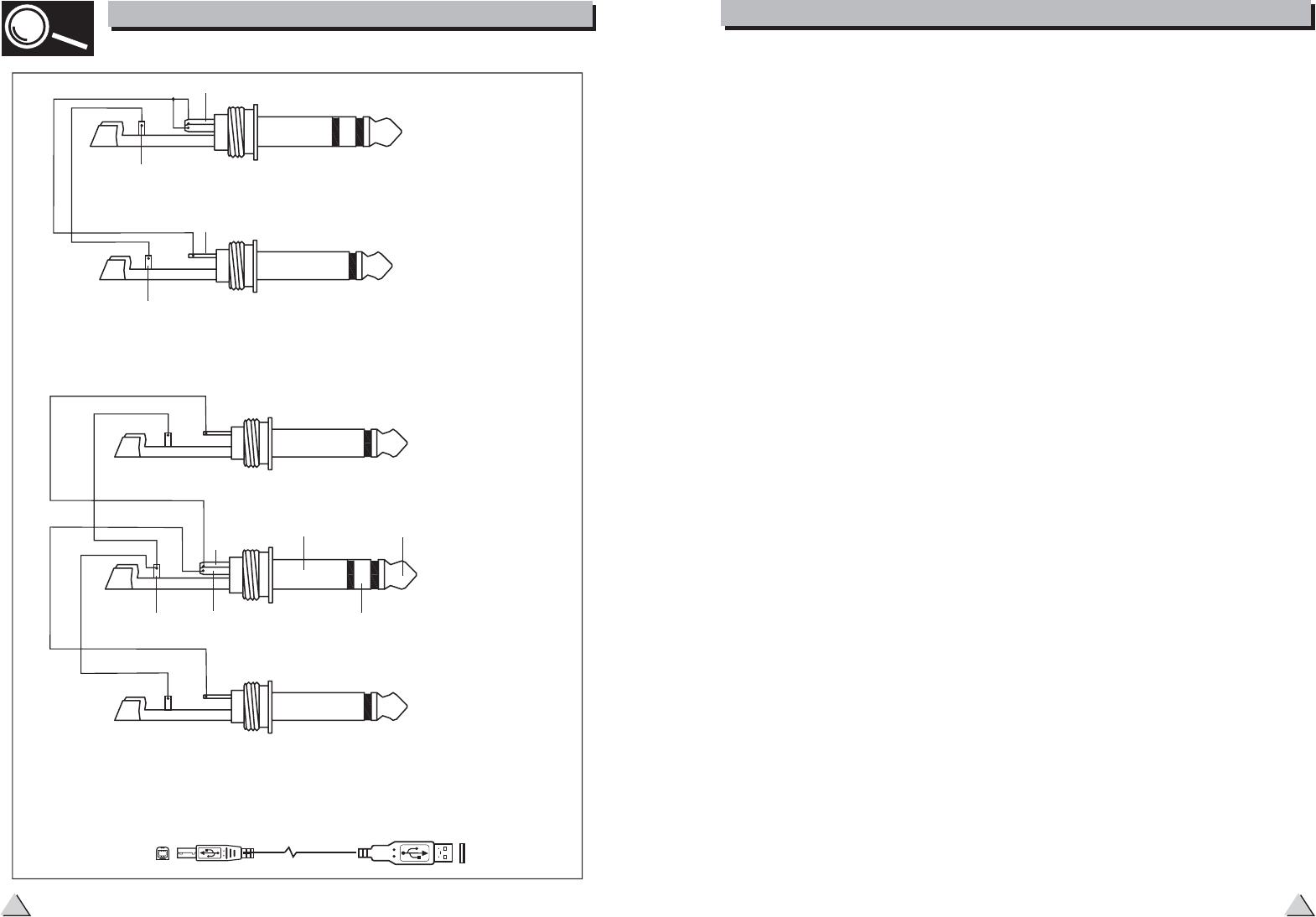
This is the fastest way to get something out from your LYNX-MIX USB Series, if you
have a keyboard and a microphone.
a. Plug the microphone into Channel 1 MIC IN.
b. Turn down AUX and LEVEL controls on the input channel.
c. Put the EQ controls on center position.
e. Turn on your LYNX-MIX USB Series.
g. If you like, you can adjust the EQ at this stage.
h. The LED on the Master LED meter should flash only occasionally, otherwise you
will hear distortion. If this LED is not active and you still hear distortion, please
turn down a little the input LEVEL control or reduce the output level of your
source instrument.
i. Connect your stereo keyboard into channel 5/6 and repeat the sequence.(for
LYNX-MIX124 USB)
Connect your stereo keyboard into channel 9/10 and repeat the sequence.(for
LYNX-MIX164 USB)
Here you are. It is your first gig with your LYNX-MIX USB Series.
f. Sing or speak into the microphone with normal volume and adjust the channel
LEVEL control of half.
3. QUICK START
Connect your stereo keyboard into channel 13/14 and repeat the sequence.(for
LYNX-MIX204 USB)
5
Sleeve=Ground/Screen
Tip=Signal
Sleeve=Ground/Screen
Ring=Return Signal (Connected together)
To Channel Insert
To Tape or FX Input
'Tapped' Connection Direct Output Lead
(Enables the Insert to be used as a Direct Output
while maintaining the channel signal flow)
Sleeve
Sleeve=Ground/Screen
Ring=Return Signal
Tip=Send Signal
To Channel Insert
To Processor Input
To Processor Output
Ring
Tip
Y-Stereo lead for insert Connection
(To be used when the processor does not employ a
single jack connection for the In/Out Connections)
USB Connection
20
5. INSTALLATION AND CONNECTION
10-7
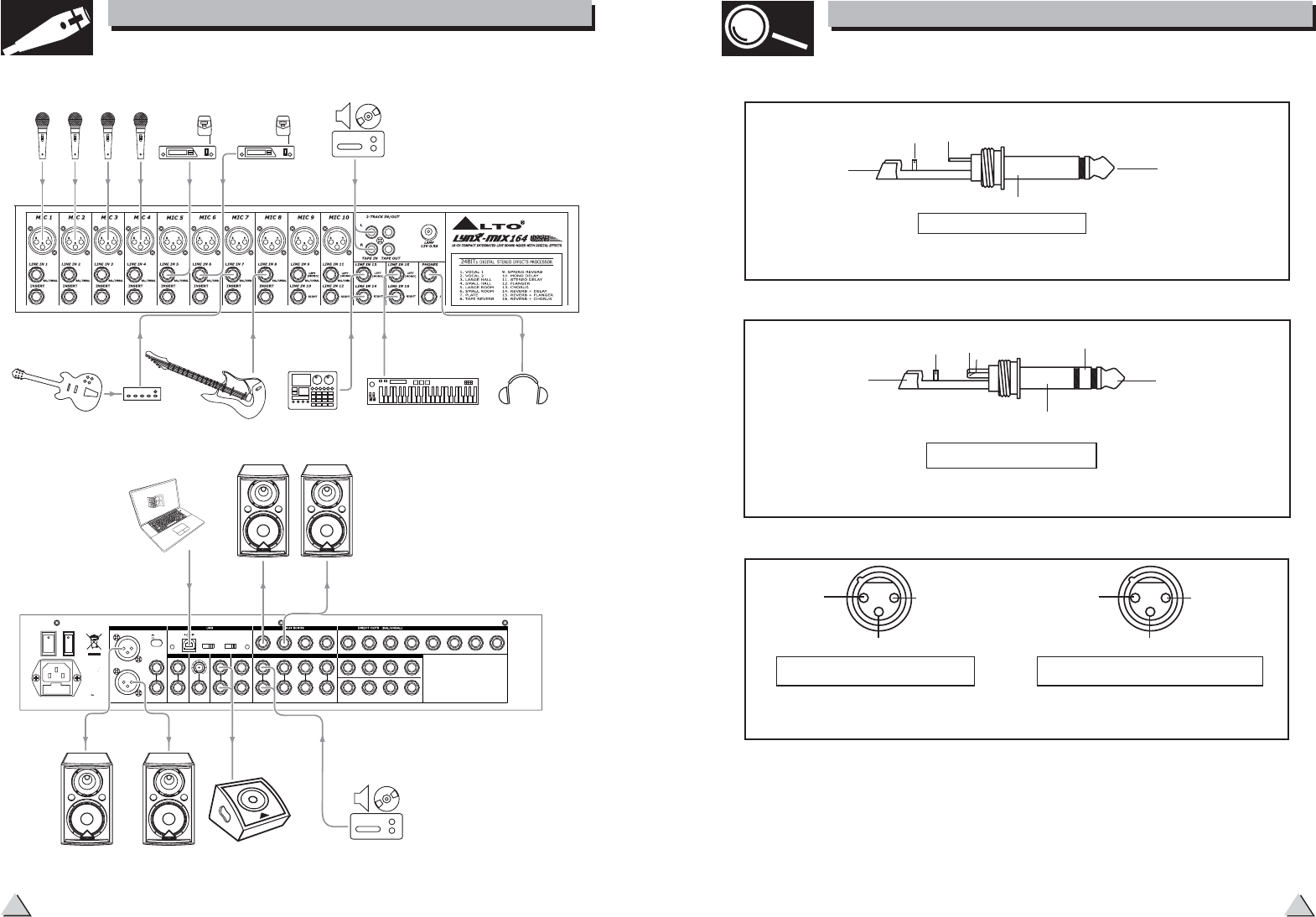
6
HOOK
UP
LARGE GIG HOOKUP DIAGRAM
CH1
CH2
CH3
AUX RETURNS
43 CH4
AUX SENDS
4
LL
SUBGROUPS OUT
3
2
41
3
RR
12
MAIN MIX OUTPUT (BAL/UNBAL)
LLLL
CTRL OUT DFX OUT
12
MONO
RING RETURN
TIP SEND
RR
FOOT SWITCH
RR
(BAL/UNBAL)
L
LEVEL
OUTPUT
MAIN
L
R
R
PHANTOMPOWER
DIRECT OUTS (BAL/UNBAL)
ON
OFF
AC INPUT
100-240V 50/60Hz
RATED POWER CONSUMPTION: 65W
Fuse: T1AL
Apparaten skall anslutas
till jordat uttag nar den
ansluts till ett natverk
CH5
CH6
CH7CH8
43
2
1
SUBGROUPS INSERT
-+15
8
0
+4dBu
-30dBu
USB
MAIN INSERT
SUB
1/2
CH
15/16
MAIN
MIX.
MAIN
MIX.
RECORD PLAY BACK
STAGE MONITOR
ACTIVE SPEAKERS
COMPUTER
ACTIVE SPEAKERS
CD PLAYER
WIRELESS
MICROPHONE 1
GUITAR D/I BOX BASS KEYBOARD
DRUM MACHINE HEADPHONE
CD PLAYER
MIC 1 MIC 2 MIC 3 MIC 4 WIRELESS
MICROPHONE 2
19
5. INSTALLATION AND CONNECTION
Strain Clamp
Sleeve Tip
Ring
Sleeve=Ground/Screen
Ring=Return Signal
Tip=Send Signal
Use for Insert Points
1/4" Stereo (TRS) Jack Plug
2=Hot(+)
3=Cold(-)
1=Ground/Screen
(seen from soldering side)
Use for Balanced Mic Inputs
(For unbalanced use, connect pin 1 to 3)
3-pin XLR Male Plug
2=Hot(+)
3=Cold(-)
1=Ground/Screen
3-pin XLR Line Socket
(seen from soldering side)
1
2
3
1
2
3
Use for Main output
(For unbalanced use, leave pin3 unconnected)
Strain Clamp
Sleeve Tip
Sleeve=Ground/Screen
Tip=Signal
Use for Mono Line In, Mono 1/4"Jack Plugs
1/4" Mono (TS) Jack Plug
10-8
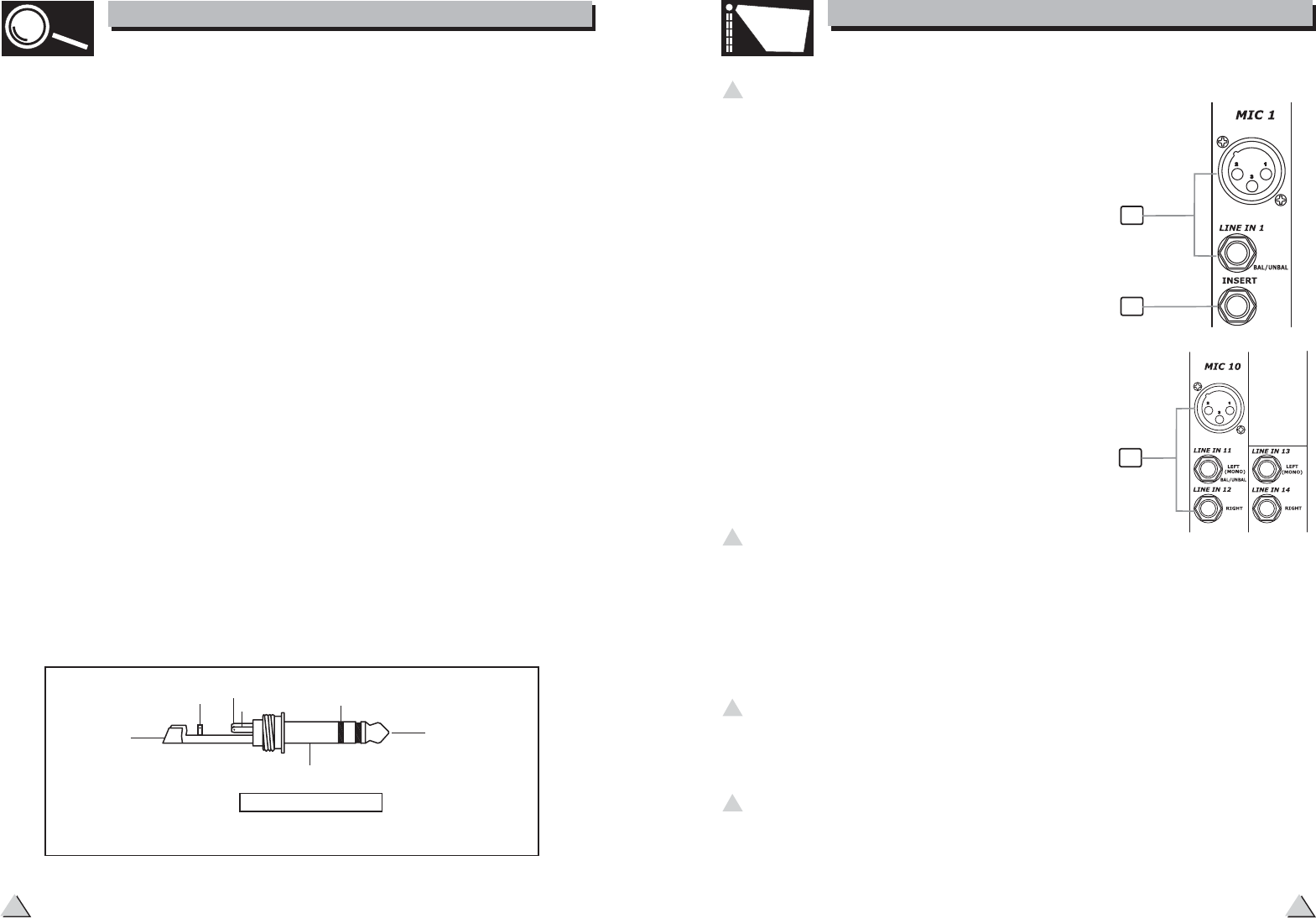
7
SPOTLIGHT
4. CONTROL ELEMENTS
1 MONO MIC/LINE Channels
Your LYNX-MIX124 USB is equipped with
4 (8 for LYNX-MIX164 USB, 12 for LYNX-
MIX204 USB) low-noise microphone pre-
amplifier with optional phantom power,
50 dB of Gain and over 115 dB of S/N
ratio. You can connect almost any type
of microphone. Dynamic microphones do
not need phantom power. Use phantom
power only with condenser microphones
but make sure that the phantom power
button is disengaged before connecting
the microphone. Phantom power will not
damage your dynamic microphones, so
make sure to read the microphone
instructions manual before engaging
phantom power. Use switch (49) to
activate/deactivate phantom power. These
channels are also equipped with 1/4" TRS
balanced/unbalanced LINE-IN plugs to
connect line-level instruments such as
keyboards, drum machines and effect
devices.
1
These are channels 5 through 12 (9 through 16 for LYNX-MIX164 USB, 13
through 20 for LYNX-MIX204 USB). They are organised in stereo pair and
provided with XLR sockets (channels 5~6 for LYNX-MIX124 USB, channels
9~10 for LYNX-MIX164 USB, channels 12~13 for LYNX-MIX204 USB) and
1/4" TRS phone jacks. If you connect only the left jack, the input will operate
in mono mode, that is the mono signal will appear on both input channels. You
can use these inputs with a stereo keyboard, drum machine, etc.
2 STEREO INPUTS
2
3
This is where you connect external sound processors such as compressor-
limiter, equalizers, etc.. The insert point is available on the first 4 (8 for LYNX-
MIX164 USB, 12 for LYNX-MIX204 USB) MIC channels only.
3 MONO Channel INSERT
4 TRIM
18
Ok, you have got to this point and you are now in the position to successfully operate
your LYNX-MIX USB Series. However, we advise you to read the following section carefully
to be the real master of your own mix. Not paying enough attention to the input signal
level, the routing of the signal and the assignment of the signal will result in unwanted
distortion, a corrupted signal or no sound at all. So you should follow this procedure
for every single channel:
1. Turn down all Input and output gain controls.
2. Connect phantom powered microphones before switching on the +48 Volt phantom
power switch.
3. Set the output level of your LYNX-MIX USB Series or the connected power amplifier
at no more than 75%.
5. Position EQ controls on middle position.
6. Position panoramic (PAN/BAL) control on center position.
8. Increase the input gain properly for maintaining the good headroom and ideal dynamic
range.
9. Depending on the actual application, turn slowly the input and output level controls
for obtaining the maximum gain before distortion.
10. Now repeat the same sequence for all input channels. The main LED meter could
move up into the red section. In this case you can adjust the overall output level
through the main mix control.
You can connect unbalanced equipment to balanced inputs and outputs. Simply follow
these schematics.
Audio Connections
5. INSTALLATION AND CONNECTION
4. Now, set the CONTROL ROOM/PHONES level at no more than 50%. In this way you
will be able to hear later what you are doing connecting a pair of headphones or a pair
of powered studio monitor speakers.
7. With a pair of headphone or studio monitor speakers are connected, apply a Line Level
input signal so that the PEAK LED does not light up.
Strain Clamp
Sleeve Tip
Ring
Sleeve=Ground/Screen
Ring=Right Signal
Tip=Left Signal
Use for Headphone
1/4" Stereo (TRS) Jack Plug
The TRIM control is applied in the mono MIC and stereo input channels. It
provides with 2 different indications: One is for the MIC and the other for LINE
levels. When you use a microphone, you shall read the MIC ring (0~50 for mono
10-9
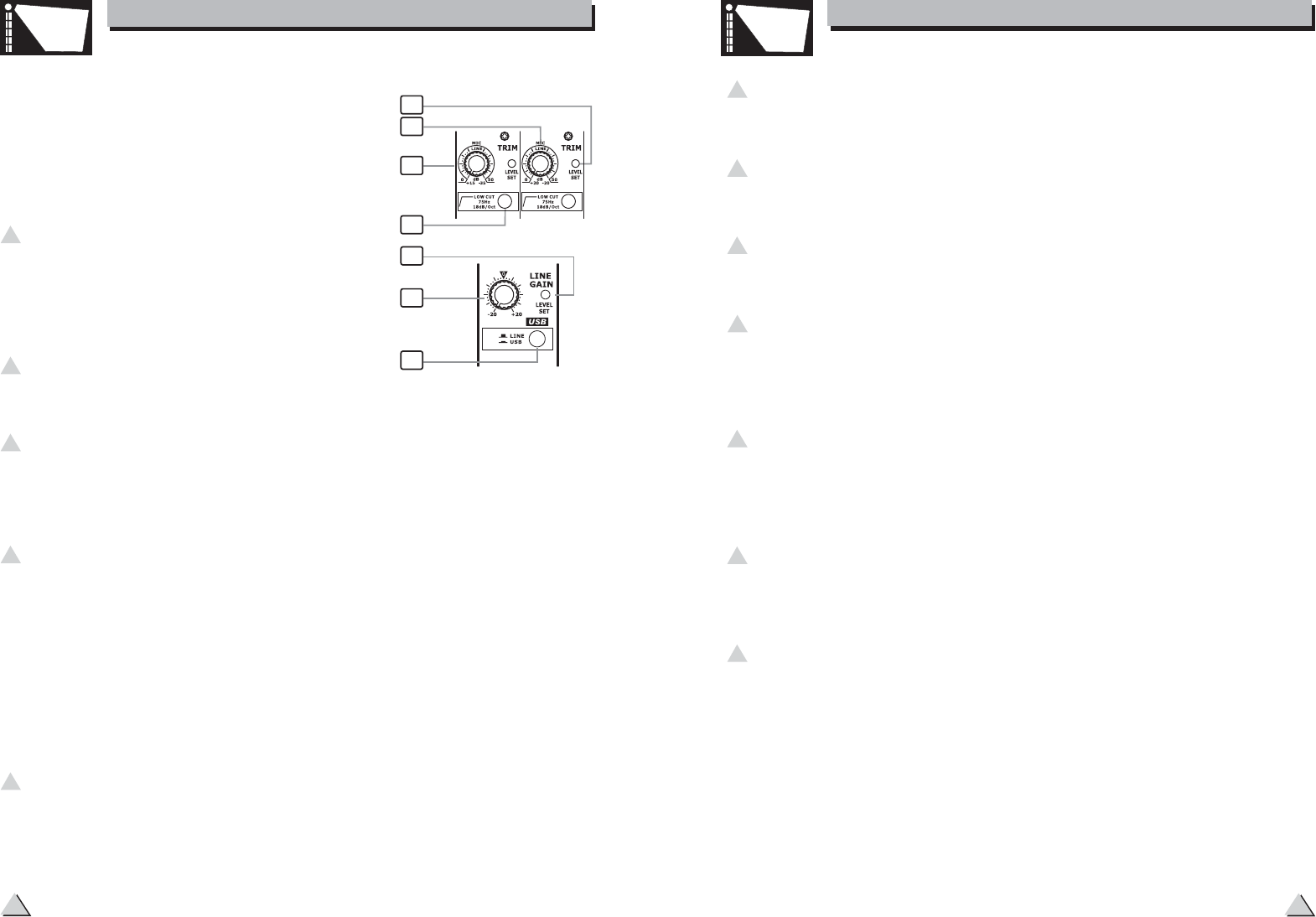
SPOTLIGHT
8
4. CONTROL ELEMENTS
4
5
5 LINE GAIN
When you use a line level instrument, you shall
read the ring (-20~+20 dB).For optimum
operation you shall set this control in a way
that the PEAK LED (16) blinks only occasionally
in order to avoid distortion on the input channel.
6 LEVEL SET LED
This LED will help you to detect the input level immediately. In this case the
research of the fault will become much faster!
6
7 LOW-CUT Button
By pressing this button you will activate a 75 Hz low frequency filter with a
slope of 18 dB per octave. You can use this facility to reduce the hum noise
infected by the mains power supply, or the stage rumble while using a
microphone.
8 LINE/USB Button
By pressing this button, it will switch to the USB mode, the USB signal will
send to this channel; when releasing this button, the LINE IN inputs signal
will send to the line input channels.
EQUALISER
There are 3-band EQ with sweepable MID on all mono input channel1-4 (1-8 for
LYNX-MIX164 USB, 1-12 for LYNX-MIX204 USB): HI, MID and LOW band. There
are 4-band fixed frequency EQ on the stereo channel5-12 (9-16 for LYNX-MIX164
USB, 13-20 for LYNX-MIX204 USB): HI, HI-MID, MID-LOW and LOW band. All bands
provide up to 15 dB of boost or cut.
8
3. CONTROL ELEMENTS
SPOTLIGHT
4. CONTROL ELEMENTS
59 DFX OUT Jack
This 1/4" phone jack is used to output the effect signal that comes from internal
DSP module and the signal level can be controlled by the EFFECTS OUT control.
60 FOOTSWITCH Jack
This 1/4" phone jack can be used to connect an external footswitch to turn on/
off the onboard effect module.
These 1/4" phone jacks are used to send out the signal from the AUX Bus to
external devices such as effect units and/or stage monitors.
61 AUX SENDS Jacks
Use these stereo 1/4" phone jacks to return the stereo signal of an effect unit
to the Main Mix. Alternatively you can also use them as an extra auxiliary input
using the AUX RETURN level control as volume control. The signal will be sent
directly to MAIN MIX control.
62 AUX RETURNS Jacks
63 DIRECT OUTS
These 1/4" phone jacks are used to connect the inputs of deck or secondary in
a complicated PA live sound system. You will find it is the best tool when you
operate the SUBGROUPS OUT.
64 SUBGROUPS OUT Jacks
65 SUBGROUPS INSERT
Each Mono MIC/LINE Channel (CH1-CH4 for LYNX-MIX124 USB, CH1-CH8 for
LYNX-MIX164 USB, CH1-12 for LYNX-MIX204 USB) is equipped with the 1/4"
phone jack for directing output. These jacks are used to send the signal from
the channel path to external device for recording function etc..
These 1/4" phone jacks are insert points. They are used to connect processors
such as compressor, limiter, EQ etc.. When insert external processor into
these jacks, the subgroup stereo signal will be taken out, then returned to
before subgroups fader. Of course, these jacks must be stereo (Tip Send/
Ring Return).
used
17
MIC input, 0~40 for stereo channels); when
you use a line level instrument, you shall read
the LINE ring (+15~-35 dB for mono MIC input,
+20~-20 dB for stereo channels). For optimum
operation you shall set this control in a way
that the PEAK LED (16) blinks only occasionally
in order to avoid distortion on the input channel.
4
6
7
If you turn this control up, you will boost all the frequencies above 12 kHz (shelving
filter). You will add transparency to vocals and guitar and also make cymbals crispier.
Turn the control down to cut all frequencies above 12 kHz. In such way you can
reduce sibilances of human voice or reduce the hiss of a Tape player.
9HI
10-10
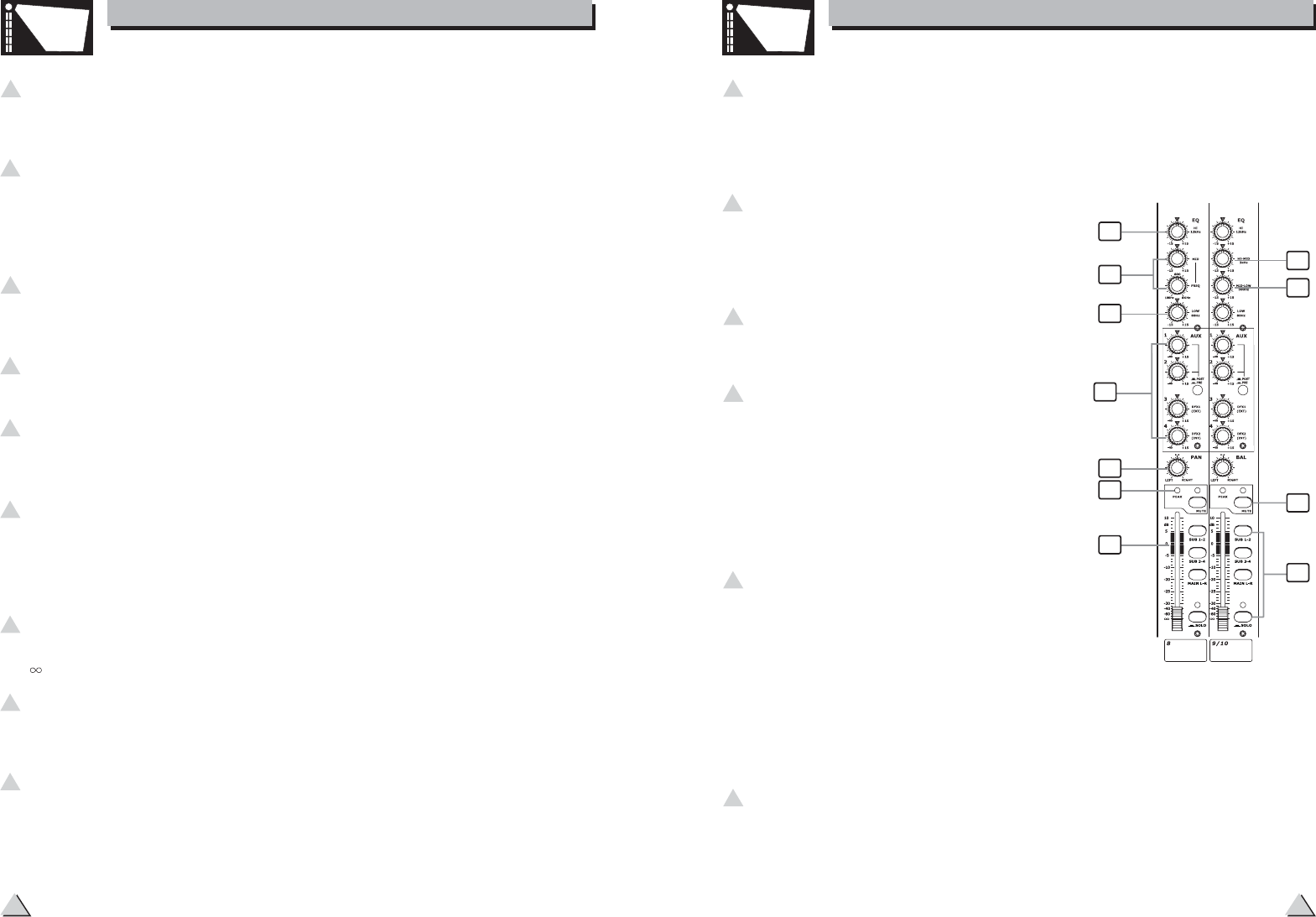
This is a peaking filter and it will boost/cut frequencies from 100 Hz to 8 kHz
depending on the position of the MID freq control. This control will affect
especially upper male and lower female vocal ranges and also the harmonics
of most musical instruments.
10 MID
11 HI-MID
This control gives you up to 15 dB boost/
cut at 3 kHz. It is useful for controlling
voice. It can accurately polish your
performance via adjusting this knob.
12 MID-LOW
This control gives you up to 15 dB boost
or cut at 500 Hz.
13 LOW
If you turn this control up, you will boost
all frequencies below 80 Hz. You will give
more punch to bass drum and bass guitar
and make the vocalist more "macho". Turn
it down, you will cut all the frequencies
below 80 Hz. In this way you can avoid
low-frequency vibrations and resonance
thus preserving the life of your woofers.
14 AUX SENDS Level Control
These four controls are used to adjust
the level of the respective signal sent
to AUX bus, AUX1 and AUX2 can be
switched to PRE/POST-FADER via the
PRE/POST button, so, generally, they
can be used for monitor application
and effects & sound processors input. AUX3 and AUX4 are configured as POST-
Faders. In this typical compact unit, excluding sending out the signal directly
to the external effect or processor equipment, AUX SEND4 can also be
assigned to the internal onboard effect module.
15 PAN/BAL Control
Abbreviation of PANORAMA control for mono channels, or the stereo channels,
always says, BALANCE control. Keep this control in center position, then the
signal will be positioned in the middle of stage.
9
10
11
12
13
14
15
16 17
18
19
9
SPOTLIGHT
4. CONTROL ELEMENTS
16
SPOTLIGHT
4. CONTROL ELEMENTS
50 MAIN MIX OUTPUT
This button sets the main mix output level to match the input of the device that
you are ready to connect. Engage this button to reduce the output level from
MAIN MIX OUTPUT by 30 dBu, it is used to match the semipro -30 dBu device,
on the contrary, to match the professional +4 dBu device.
51 MAIN OUTPUT LEVEL Button
These stereo outputs are supplied with both the XLR and 1/4" phone jacks
and it is controlled by the Main Mix Level.
52 USB PORT
This USB port is used to connect the unit to PC with the supplied transmission
line.
53 USB RECORD Switch
You can select SUB1/2 or MAIN MIX track to input the record signal to PC.
54 USB PLAYBACK Switch
You can select CH11/12 (CH15/16 for LYNX-MIX164 USB, CH19/20 FOR LYNX-
MIX204 USB) or MAIN MIX track to output the audio signal from PC.
55 MAIN INSERT
These 1/4" phone jacks will be used to send the Control Room signal to the
studio monitor speakers or a second set of PA.
58 CTRL OUT Jacks
This 1/4" phone jack is balanced/unbalanced mono mix output connector, it can
be regarded as a sum output of the left and right of MAIN MIX.
57 MONO OUTPUT Jack
This knob sets the level of mono mix output signal, which can be varied from
- to +15 dB.
56 MONO Level Control
These two 1/4" phone jacks are stereo insert points and used to connect
processors such as compressors, equalisers etc.. When insert a external
processor into the jack, the Main stereo signal will be taken out after the EQ
and returned into the MAIN MIX output before the MAIN MIX fader.
10-11
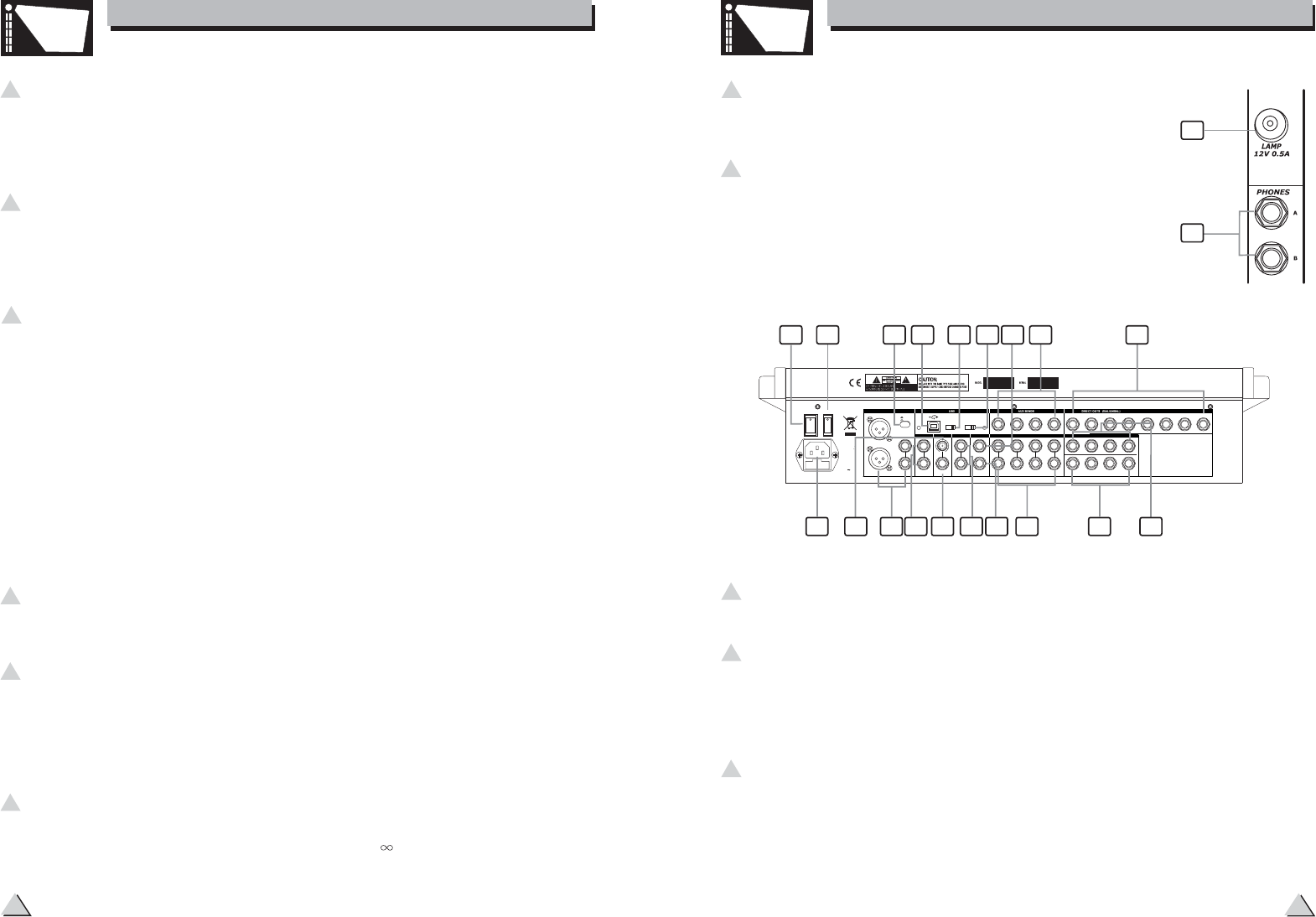
10
Each channel is equipped with a MUTE button. Pressing this button is equal
to turning the fader down, which can mute the corresponding channel output
except for the channel INSERT send and SOLO (in PFL mode). And the MUTE
LED will illuminate.
Inside your LYNX-MIX USB Series the audio signal is monitored in several different
stages and then sent to the PEAK LED. When the LED is red illuminated, it warns
you that you are reaching signal saturation and possible distortion, then you should
reduce the input level for avoiding distortion.
16 PEAK LED
SPOTLIGHT
4. CONTROL ELEMENTS
17 MUTE Button & LED
18 ASSIGNMENT Controls
Each channel provides four push-buttons: SUB1-2, SUB3-4, MAIN L-R and SOLO.
Pressing the SOLO button, the corresponding SOLO LED will illuminate and the
SOLO signal will replace other signals send to the Headphone/Control Room and
Meters. Usually use the SOLO function in live work to preview channels before
they are let into the mix. It is useful to set an instrument's input level and EQ,
and you can also solo any channel that you want to. The SOLO switch never
affects any mix other than the Control Room. The other three buttons can be
considered as signal assignment switches. Pressing the SUB 1-2 will assign the
channel signal to Subgroup1/2, you can depend on the PAN switch to adjust the
amount of channel signal sent to the SUB1 versus SUB2, when turns the PAN
to completely left, then the signal can be only controlled by Subgroup1 and vice-
versa. In the same way, pressing the SUB 3-4 or MAIN L/R will assign the channel
signal to Subgroup3/4 or MAIN MIX L/R, and will also be affected by PAN.
19 FADER
This fader will adjust the overall level of this channel and set the amount of signal
send to the main output.
20 Control Room Source
You can choose to monitor any combination of MAIN MIX, SUB1-2, SUB 3-4 and
2TK IN via these Matrix switches. Engaging these switches, the stereo signals
will be delivered to the Phones, Control Room and Meters display.
Note: When any SOLO switch was engaged, the SOLO signal will replace other
signals, and also be sent to the Control Room, Phones and Meters.
21 PHONES/CTRL ROOM Controls
Rotate these knobs to adjust the stereo level of CTRL ROOM and PHONES
outputs separately, which can be varied from - to MAX.
3. CONTROL ELEMENTS
SPOTLIGHT
4. CONTROL ELEMENTS
15
These jacks will be used to send the signal to a pair
of headphone or to powered studio monitors.
45 PHONES Jack
46 LAMP
This lovable LAMP is very convenient for your operation,
it is located in the top right corner of the front panel,
and provides the 12V socket that can drive standard
BNC-type lamp.
46
45
CH1
CH2
CH3
AUX RETURNS
43 CH4
AUX SENDS
4
LL
SUBGROUPS OUT
3
2
41
3
RR
12
MAIN MIX OUTPUT (BAL/UNBAL)
LLLL
CTRL OUT DFX OUT
12
MONO
RING RETURN
TIP SEND
RR
FOOT SWITCH
RR
(BAL/UNBAL)
L
LEVEL
OUTPUT
MAIN
L
R
R
PHANTOMPOWER
DIRECT OUTS (BAL/UNBAL)
ON
OFF
AC INPUT
100-240V 50/60Hz
RATED POWER CONSUMPTION: 65W
Fuse: T1AL
Apparaten skall anslutas
till jordat uttag nar den
ansluts till ett natverk
CH5
CH6
CH7CH8
43
2
1
SUBGROUPS INSERT
-+15
8
0
+4dBu
-30dBu
USB
MAIN INSERT
SUB
1/2
CH
15/16
MAIN
MIX.
MAIN
MIX.
RECORD PLAYBACK
Rear Panel
This switch is used to turn the main power ON and OFF.
47 POWER ON/OFF Switch
48 +48 Volt Phantom Power
It is available only to the XLR MIC sockets. Never plug in a microphone when
phantom power is already on. Before turning phantom power on, make sure
that all faders are totally down. In this way you will protect your stage
monitors and main loudspeakers.
47 48
Use it to connect your LYNX-MIX USB Series to the main AC with the
supplied AC cord. Please check the voltage available in your country and how
the voltage for your LYNX-MIX USB Series is configured before attempting
to connect your LYNX-MIX USB Series to the main AC.
49 AC Inlet with FUSE Holder
49 50
51 52 53 54
5556 57 58
59
60
61
62
63
6465
10-12
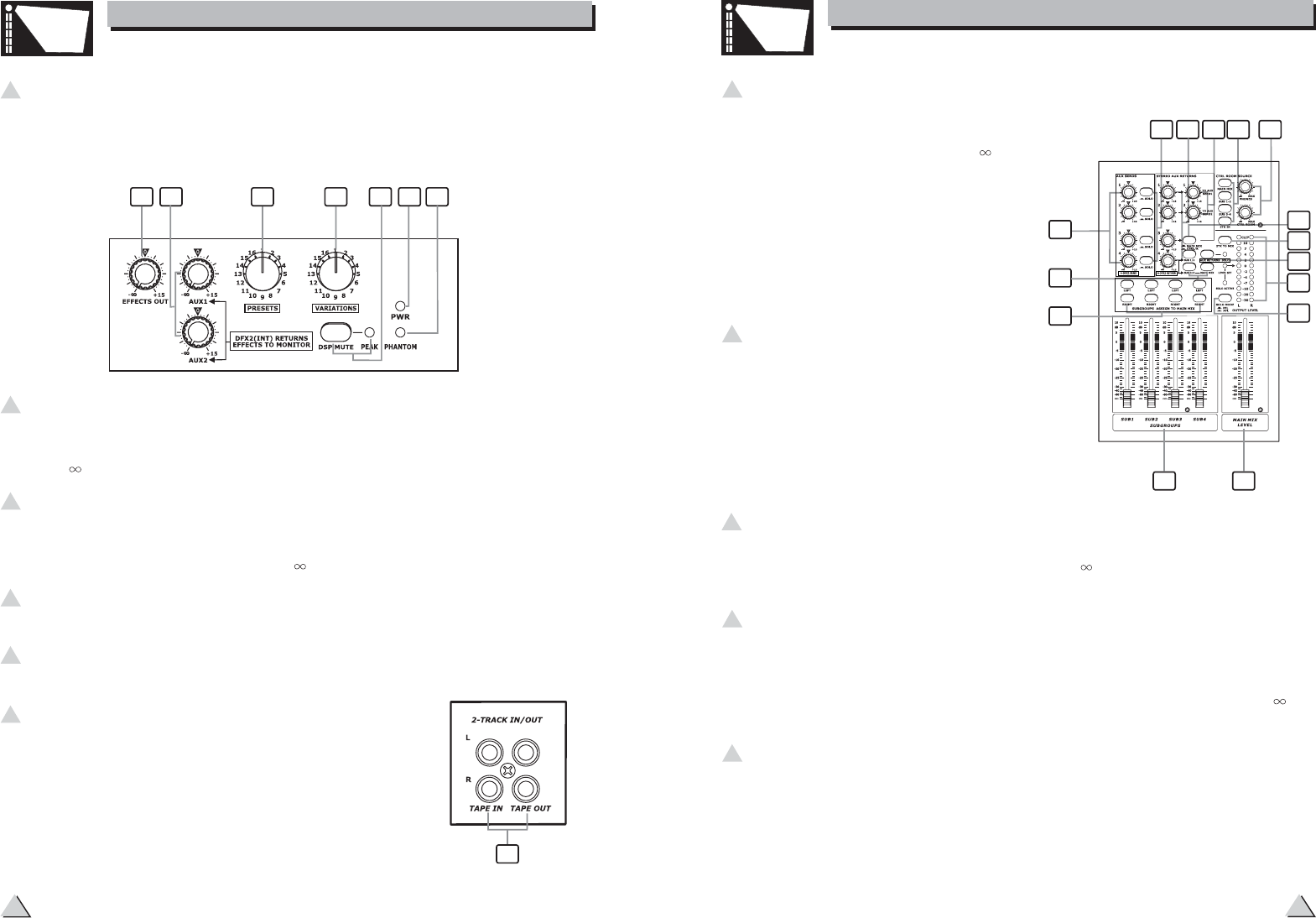
SPOTLIGHT
4. CONTROL ELEMENTS
11
20 21
22 Master AUX SENDS Controls
The four controls are used to
determine the master AUX SEND
levels, which can be varied from -
to +15 dB. When the external effect
unit connected to mixer has no input
gain control, you can get a further
+15 dB gain available from these AUX
SEND outputs. As to the AUX4, it
can also provide the lovable level
adjustment for the internal effect
signal.
23 SOLO Button
The function of these SOLO buttons
are the same as the channel SOLO
button, they can also be affected
by SOLO MODE switch. Press the
SOLO button, the corresponding
AUX send will be routed to CTRL
ROOM/PHONES outputs and Meters
display.
22
23 24
24 Master STEREO AUX RETURNS Controls
These four controls set the level of effects that received from the stereo AUX
RETURN connectors, which can be varied from - to +15 dB. They are used to
provide the further gain for low level effects.
25
25 TO AUX SEND1/2
The both rotary knobs assign the AUX RETURN signals to their respective
AUX SEND outputs: The TO AUX SEND1 assign the signal from AUX
RETURN1 to AUX SEND1 bus, and TO AUX SEND2 assign the signal from
AUX RETURN2 to AUX SEND2 bus. The adjustable range goes from - to
+15 dB.
26
27
28
29
30 31
32
33
34
AUX RETURN3 is equipped with the MAIN MIX & CTRL/R button. Release the
button to send the stereo signal from AUX RETURN3 to MAIN MIX buses;
Engage the button, then the stereo signal will be sent to CTRL/R output.
26 MAIN MIX & CTRL/R Button
3. CONTROL ELEMENTS
SPOTLIGHT
4. CONTROL ELEMENTS
14
39 DSP MUTE Switch & PEAK LED
This switch is used to activate/deactivate the effect facility. This LED lights up
when the input signal is too strong. In case of the digital effect module being
muted, this LED also lights up.
40 EFFECTS OUT Control
Rotate this knob to adjust the level of effect signal that intercepted from
internal DSP processor and directly sent to DFX OUT, which can be varied
from - to +15 dB.
41 DFX2 (INT) RETURN EFFECTS TO MONITOR
The AUX1 and AUX2 controls are used to set the signal level from AUX
RETURN4, which signal will be sent to AUX SEND1 and AUX SEND2. The
adjustable range can be varied from - to +15 dB.
42 POWER LED
The LED indicates when the Power is on in your LYNX-MIX USB S .eries
43 PHANTOM LED
This LED indicates when the Phantom Power is switched on.
-TAPE IN
Use the Tape input if you wish to listen to your mix
from a Tape Recorder or DAT.
- TAPE OUT
These RCA jacks will route the main mix into a tape
recorder.
44 2-TRACK IN/OUT
44
37 38 3940 41 42 43
10-13
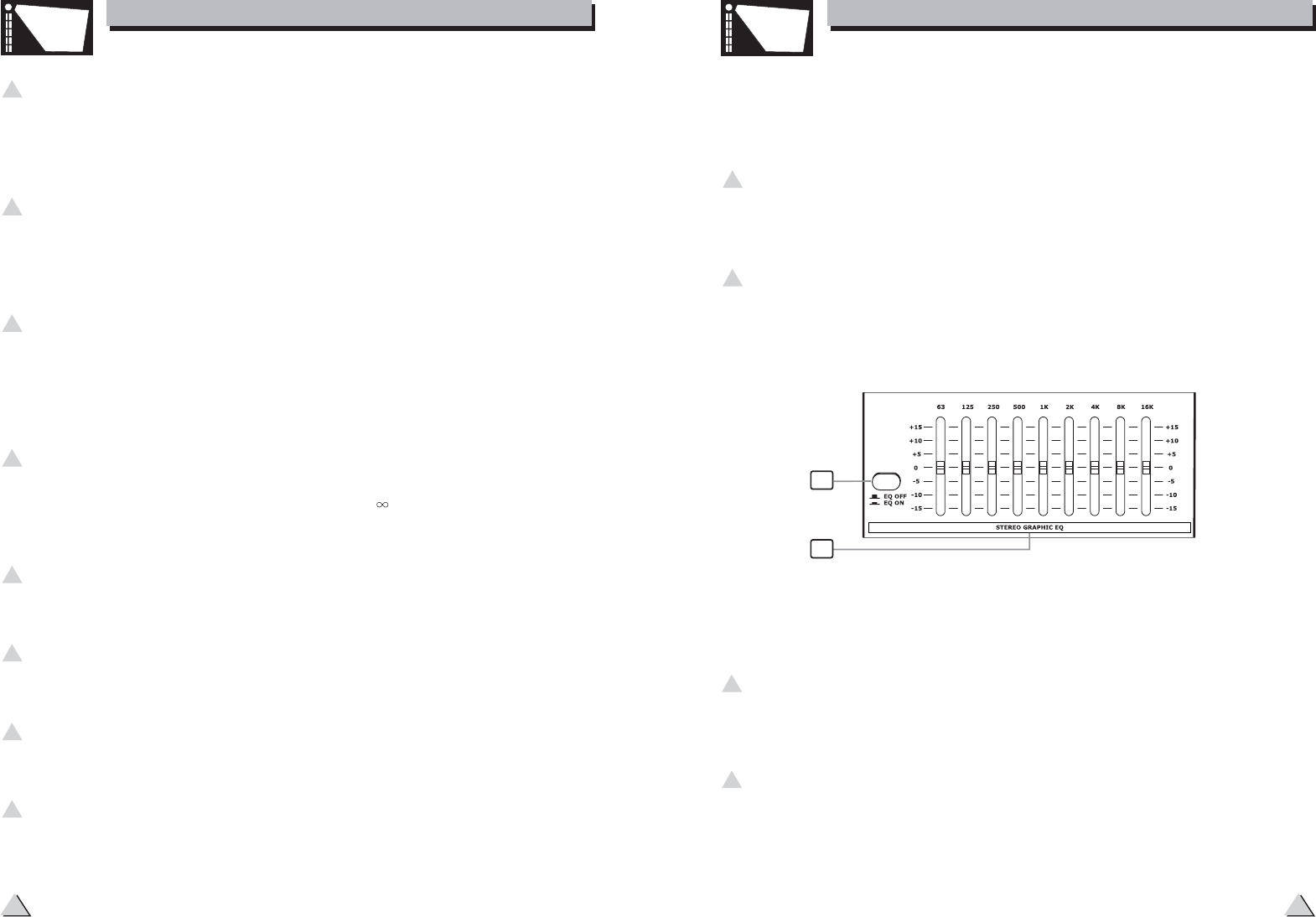
Adjust this knob to select the right effect you wish to perform. There are total
16 options for you: several kinds of reverb, mono and stereo delay, effects with
modulation, and versatile two-effect combination.
37 PRESETS
38 VARIATIONS
Since you have selected the preferable effect, the next step, please go with the
fine consideration, there are also total 16 variations for each preset, and each
variation may be managed by several different factors.
SPOTLIGHT
4. CONTROL ELEMENTS
13
after the Level control, otherwise, release the button will output the soloed
signal before the Level control. Please note that the SOLO function can never
affect the mix at main recording output, and also can't be affected by channel's
MUTE switch.
Each one of these faders will boost or attenuate (+/-15 dB) the selected frequency
at a preset bandwidth. When all the faders are in the centre position, the output
of the equalizer is flat response.
35 EQ Switch
Engage this button to add the stereo graphic EQ into the main mix output circuit.
It can be used to modify the frequency "contour" of a sound. If you release the
button free, the stereo graphic EQ will be bypassed.
36 STEREO GRAPHIC EQ
DSP SECTION
There is a powerful 24-bit/256 preset multi-effects included in your LYNX-MIX USB
Series. Effects include reverbs, chorus, flanger, delay and combinations of the above.
35
36
SPOTLIGHT
4. CONTROL ELEMENTS
12
27 SUB1-2/SUB3-4/MAIN MIX Buttons
These three buttons are configured for AUX RETURN4, they can be regarded
as the signal assignment switches. When engaging the SUB1-2, the stereo
signal from AUX RETURN4 will be assigned to Subgroup1/2; in the same way,
SUB3-4 for Subgroup3/4, MAIN MIX for MAIN MIX buses.
28 AUX RETURNS SOLO Button
The function of AUX RETURN SOLO is like the channel SOLO button. Engaging
it sends the signal from AUX RETURN (1-4) to the CTRL OUT, PHONES outputs
and Meters display. It can also be affected by SOLO mode button, and the LED
next to the button will illuminate.
29 SUBGROUPS ASSIGN TO MAIN MIX
Through these switches, you can operate the subgroup faders as a master
control for assigning the subgroups to MAIN MIX. Engage the LEFT switch to
send the corresponding subgroup signal to MAIN MIX L, and the RIGHT switch
for MAIN MIX R. When engaging the both switches, the signal will be sent to
L/R of MAIN MIX.
30 SUBGROUPS Fader
These faders are used to control the levels of the signal send to the SUB-
GROUPS OUT, the adjustable range goes from - to +10 dB. Any channel
that is assigned to the subgroups, not muted and not turned down will be
assigned to the SUB OUTS.
31 MAIN MIX LEVEL Fader
This fader sets the amount of signal send either to the Main Mix Output or to
the Tape Output.
32 LED Meter
The stereo 12-segment LED Meter will indicate the signal level send to the
CTRL ROOM and PHONES outputs.
33 2TK TO MIX Button
Engaging this switch allows you to combine the 2 TRACK Output with the MAIN
MIX. In other words, feeds the 2 TRACK IN signals into MAIN L/R output.
34 SOLO MODE Button
This button provides two modes: up for PFL (Pre-Fader-Listen) mode, down for
AFL (After-Fader-Listen) mode. Engage the button, the soloed signal will output
10-14